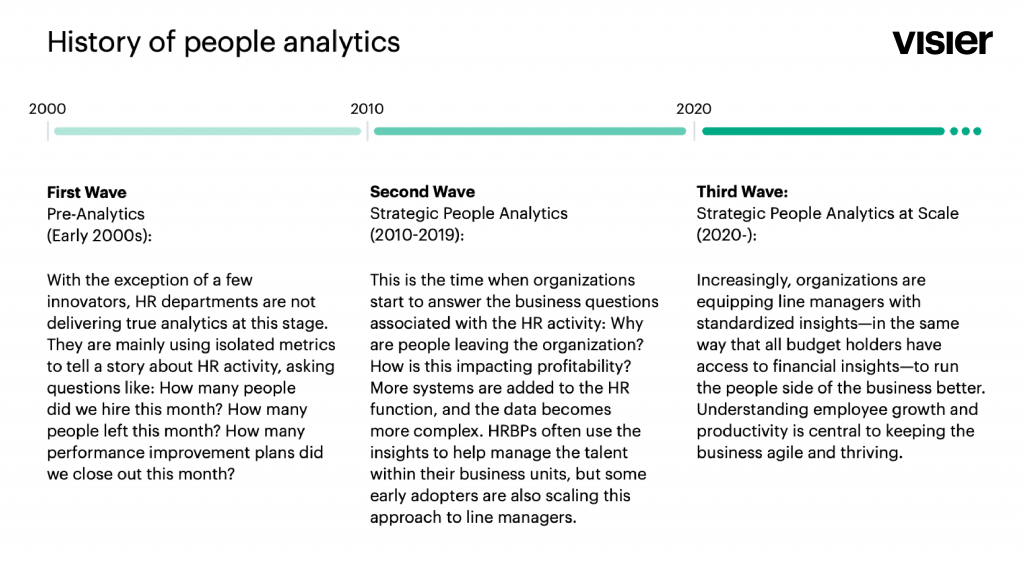Why People Managers Need People Analytics Today
Many organizations struggle to help managers make better people decisions. But others are thriving. What separates the haves from the have-nots?

Sometimes, good managers make bad talent decisions. Without the right information, it’s tricky to make the right call about a promotion or a pay raise demand. And with hybrid working models expected to become the norm, the pressure on managers will only intensify.
Good managers are drivers of positive employee experiences, and at people-focused organizations, more managers than ever need strong decision-making support–and yet there are fewer HR business partners (HRBPs) around to help.
This is where people analytics enters the picture. When approached correctly, a people analytics platform takes data sitting in multiple systems, processes it, and puts it directly in the hands of non-technical users. This helps managers answer the complex questions that crop up daily: Should Asher be considered for this leadership training program? Should I give John a raise?
Our own research shows that organizations thrive when the ability to retrieve insight goes beyond the data science and reporting teams. Having a small number of expert users does not work–unless they are serving just a handful of individuals in the upper echelons of the organization. And I am willing to wager that your C-suite leaders are not the ones making the day-to-day hiring and promotion decisions at your company.
The consumption of data needs to happen on a much broader scale, to all individuals who are making choices about who gets hired or promoted. When you think about it, that’s a lot of employees who need people insights: for a typical organization, anywhere from 8% to 12% of its people will have a managerial role.
Achieving this level of scale with people analytics may seem like a tall order, but many organizations are doing this already:
Since implementing Visier in 2016, Merck KGaA has grown its user base to a network of 3,500 users, which includes the entire management population of business and people leaders, plus the HR function. Line managers make up 3,000 of these users.
Within 12 months of relaunching their people analytics program, Uber was serving more than 1,000 managers with tailored insights about their people.
The third wave of people analytics: It’s about scale
Not all organizations are at this level of scale yet, but this is where the mainstream is heading. This momentum has been building for decades, occurring in three distinct waves:
First Wave: Pre-Analytics (Early 2000s)
With the exception of a few innovators, HR departments are not delivering true analytics at this stage. They are mainly using isolated metrics to tell a story about HR activity, asking questions like: How many people did we hire this month? How many people left this month? How many performance improvement plans did we close out this month?
Second Wave: Strategic People Analytics (2010-2019)
This is the time when organizations start to answer the business questions associated with the HR activity: Why are people leaving the organization? How is this impacting profitability? More systems are added to the HR function, and the data becomes more complex. HRBPs often use the insights to help manage the talent within their business units, but some early adopters are also scaling this approach to line managers.
Third Wave: Strategic People Analytics at Scale (2020-)
People analytics has been automated to the point where organizations can equip line managers with tailored insights–in the same way that all budget holders have access to financial insights–to run the people side of the business better.

Beware “The Scalability Wall”
Some organizations are entering this third wave with relative ease, others are more challenged. They hit what is called “the scalability wall”—and it has a lot to do with how they are approaching the underlying technology.
The seed of the problem begins when traditional BI tools are used as the only means to create people insights, an approach that is often mandated by IT leaders who have committed to a particular BI vendor or stack. The issue also arises when the focus of the people analytics program starts with just the data. This creates a need to assemble multiple data sources, with the traditional solution to this being a data warehouse or lake.
The challenge is that data warehouses/lakes are built to hold data–not analyze it. Every time there is a new question or business requirement, a data expert needs to extract the relevant pieces from the warehouse and assemble them into a discrete analytical model. Each unique analytic output requires a technical person to customize, maintain, and update it when things change. And when it comes to people data things change frequently!
It’s similar to the pre-industrial approach to cloth manufacturing: each artisan makes batches of cloth from their workshop, and the only way to scale is to add more people. Data scientists and reporting experts are like the cloth making artisans. Using the generic BI approach, their workload quickly gets filled up with maintaining and updating existing assets, rather than creating new ones. The tools used mean that the only way to make enough bespoke analytics is to add more people.
Here’s an example of what this looks like in the real world: A few years ago, I had a conversation with a services organization that had created 15 analytic outputs (dashboards), serving 20 executives. They had a team of three full-time employees who were stretched to support and maintain this volume of output. The leader had a list of 50 new analytic outputs that the business wanted. Based on their existing technology and ratio of people to outputs, that meant adding 10 more full time employees—tripling the team!

Analytic applications: The scalability advantage
There is a way to add more value without having your data teams balloon to an unsustainable size.
Modern analytic applications move the whole process of data preparation, analytic modeling, and distribution into one discrete application. They automate the data preparation stage, standardize all metrics, filters and hierarchies, and centralize security so that an unlimited number of analytics outputs can be created and shared. All changes are made once, centrally, so that all of the live outputs inherit these updates.
These applications include all of the metrics, visualizations, security, and storytelling required to create an unlimited number of insights. These systems can be fed from a data warehouse or lake if it exists—and can also be fed simultaneously from other source systems. Blending the best of both approaches can reduce the time spent data wrangling by up to 80%. More importantly, value increases in proportion to the number of users—shifting from 20 executives to 1000 people managers, which delivers a huge ROI.
This evolution in practice is similar to what happened in the world of cloth making, which moved from being produced by isolated artisans to being produced at scale through automation and standardization.
For HR leaders, this approach offers several advantages. Here are two of them:
1. Ensure the right people see just want they need to see
People data is sensitive data. Information about things like an individual’s rate of pay or performance history should be treated with care. This means that a manager only needs to see details for direct reports, not everybody in the organization, and when reviewing trends about people who are outside their hierarchy, the manager only needs an aggregate view of the data.
A ready-made analytic engine helps by enabling many managers to view the same data asset, but in different degrees of detail. All of the information comes from the same analytic model and all of it is driven from the same metrics—but it is presented in different ways so that people only see what they need to see.
Modern analytic applications like Visier also provide a far superior experience to the end-user, which allows people managers to make decisions about their employees informed by the relevant cross organization information.
2. Provide standardized, “decision-ready” insights
Before using a people analytics solution, hospital units at a major healthcare provider would open requisitions based on gut feel. Now, unit managers can only open a requisition if the data shows productivity is above a certain threshold, thus enabling cost-effective, quality patient care.
This business would not have been able to allocate the IT resources required to deliver this kind of standardized “decision-ready” output using traditional BI tools. The cost and time to build and maintain this level of user focused output would have been prohibitive.
With Visier, standard definitions for metrics like turnover and productivity are also pre-defined, which makes it possible for individual managers to make decisions that align with overall organizational goals based on apples to apples comparisons.
People analytics everywhere
HR is evolving from being focused on its programs and activities to helping people managers make better decisions in the flow of work.

This leads to better HR practice, which then leads to the ultimate goal: better business results. The trend towards a kind of people analytics that is standardized and broadly deployed has been building for years—and there has never been a better time to get started.


